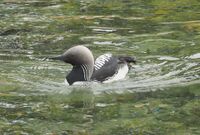Loon
| Loon | |
|---|---|

| |
| Pacific Loon Gavia pacifica | |
| Scientific classification | |
| Kingdom Information | |
| Domain | Eukaryota |
| Kingdom | Animalia |
| Subkingdom | Bilateria |
| Branch | Deuterostomia |
| Phylum Information | |
| Phylum | Chordata |
| Sub-phylum | Vertebrata |
| Infraphylum | Gnathostomata |
| Class Information | |
| Superclass | Tetrapoda |
| Class | Aves |
| Sub-class | Neornithes |
| Infra-class | Neognathae |
| Order Information | |
| Order | Gaviiformes |
| Sub-order | Ciconii |
| Infraorder | Ciconiides |
| Family Information | |
| Family | Gaviidae |
| Genus Information | |
| Genus | Gavia |
| Population statistics | |
Loons, also known as divers in the British Isles, are several species of birds of the family Gaviidae, and found over much of the high latitudes of the northern hemisphere.
Description
Loons are fairly large waterfowl, about the size of a large duck, and in the water from a distance they can be mistaken for ducks. The body is fairly compact, dark above with a white underbelly. Wings are pointed, with a shape more akin to a gull than a duck. Males are slightly larger than females, and look much alike throughout the year, except during the breeding season, when males take on bold white mottling and streaks, and pastel grays and reds on the head and neck, depending on the species.
The name "loon" has its origins in the Skandinavian lōmr, and quite literally means a simpleton or crazy person[1]. In reference to the bird, however, the same Skandinavian word may have given rise to the word "lummox"[2], which means a clumsy or awkward person. Certainly, the loon's way of walking on land - with small legs set far back - implies this. The English name "diver" is appropriate; loons are powerful swimmers, catching fish underwater with little effort.
Species
- Arctic loon, Gavia arctica
- Common loon, Gavia immer
- Pacific loon, Gavia pacifica
- Red-throated loon, Gavia stellata
- Yellow-billed loon, Gavia adamsii
Evolutionary claims
The oldest claimed date for a fossil loon is about 23 million years ago in the early Miocene epoch, and was identified as a loon in 2008[3].
Creation science states that loons, and all other birds, were deliberately created by an act of God some six thousand years ago during the fifth day of the creation week, according to Genesis, ch. 1:20-23; indeed, all fossil evidence has shown the sudden appearance of any given animal, with no evidence of a transitional period. In loons, the absent transitional evidence needed to be seen is the gradual relocation of the legs to the extreme rear of the animal.